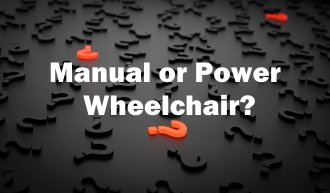Should You Choose a Manual or Power Wheelchair?
When it is time to buy a wheelchair for yourself or a loved one, many considerations go into the purchase decision. Begin by consulting with your healthcare provider to identify the type of wheelchair that will best meet your mobility requirements. Choosing the right wheelchair will further your independence and enhance quality of life. Comfort, ease-of-use, and safety are key factors to keep in mind during the buying process.

As you evaluate your options, think about the type of environment where you will use your chair, such as in your home, public buildings and/or outdoors. Take into account how many hours during the day you will use your chair. Also, factor in whether you will be propelling the chair yourself or if you require assistance moving around.
One of the first choices in the purchase process is to determine whether you want to look at manual or electric wheelchairs. The following information provided by wheelchair expert Scott Zabriskie of Scooters 'N Chairs will help you make this decision.
Ease of Mobility
Depending on your specific circumstance, a manual wheelchair may offer more difficult overall mobility than an electric power chair. If you are propelling the chair yourself, a manual wheelchair may present challenges for all-day or long-distance movement. Upper-body strength and endurance is required to maneuver your chair and turn the large rear wheels for an extended period of time, as you navigate various pathways and around obstacles.
Electric wheelchairs feature a battery, motor and other parts to make them self-propelled and drivable with little effort. The person sitting in the chair utilizes a joy stick to move forward and direct the chair. These wheelchairs are suited for individuals who do not have upper-body strength or a caregiver who can push them. Power wheelchairs can easily go up and down hills or around curves, while the user maintains full directional and speed control.
Comfort Factors
Since power wheelchairs are often designed for long-term mobility, they typically feature more seat padding and support than manual wheelchairs. If a person has a painful chronic condition, he or she may prefer a power wheelchair because it offers a softer, thickly padded seat.
A manual chair usually features thinner seat and back padding so the chair is easier to fold and transport. Additionally, electric models have evenly-distributed wheels that move smoothly along level surfaces. Some power wheelchairs feature all-terrain wheels for uneven surfaces. Power wheelchairs reduce the jarring movements that typically occur when someone tries to force a manual chair to move in a particular direction.
Cost and Upkeep
Many people choose manual wheelchairs because they meet their mobility requirements, are easier to transport, and are less expensive than electric wheelchairs. A power chair has a lot more parts and an electrical system that can break down at any time from something as simple as a dead battery, faulty wire or broken circuit board. Some models have complex systems that require expensive future software or hardware updates.
A manual wheelchair simply has a
seat, back, handles, arms, leg rests and wheels, which make it much less expensive. In contrast, an individual or his/her insurance company pays a lot more upfront for an electric chair, plus maintenance and possible repair costs, than for a manual wheelchair that requires far less upkeep.
Transportability
When comparing ease of transport, manual wheelchairs are the obvious choice. A manual chair is lightweight and typically folds or collapses in a way that makes it fit well in most standard-sized automobile trunks. An electric wheelchair typically requires a special van or large-headroom vehicle that features a lift or ramp if the user wants to go somewhere on his/her own or travel with someone else. There are some newer power wheelchair models on the market that have the capability to fold for easier transport.
Some people use an electric wheelchair at home and a manual one when traveling with a caregiver.
Final Thoughts - Looking to the Future
According to Mr. Zabriskie, battery-powered robotic leg braces and exoskeletons may become a potential alternative to wheelchairs for people who suffer from leg paralysis. These advanced assistive devices are still in the early stages and currently can cost tens of thousands of dollars for consumers. Yet, they represent promising technology for the future that will become increasingly affordable.
Automobile manufacturers have also come up with new vehicle designs that make it possible for wheelchair users to simply roll into their cars and drive away while still seated – without depending on lifts, ramps or trunk storage.
Related Information - Manual or Power Wheelchair
Mobility Chairs - A Primer
Power Chair Purchase Considerations
Mobility Resources
Power Chairs - Types and Models
Mobility Scooters - Buying Tips
Popular ArticlesTypes of Mobility Chairs Wheelchair Sports Activities Helpful Resource Organizations Mobility Scooter Buying Tips Portable Ramp Options |


